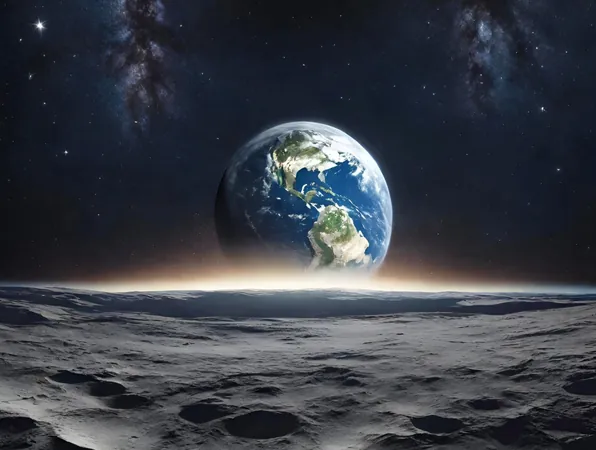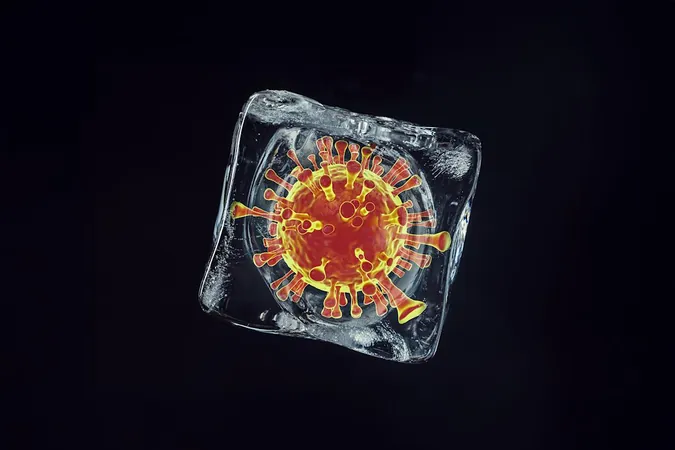
Revolutionary Discoveries on the Moon's Farside: Is it Really Drier Than We Thought?
2025-04-15
Author: Li
Unearthing Lunar Secrets
Recent groundbreaking research unveils that the Moon's farside might harbor significantly less water within its mantle than the side visible from Earth. This revelation challenges prior assumptions about the Moon's evolution and prompts intriguing questions about its formation.
A Surprising Hemispheric Divide
A team of scientists from China, analyzing samples from the moon’s enigmatic farside gathered during the Chang'e-6 mission, discovered a stark contrast in water distribution between the two hemispheres. While some historical missions showed variations with 1 to 200 micrograms of water per gram of lunar material on the near side, the new findings suggest the farside may lean towards the incredibly dry end of that spectrum.
A Landmark Exploration
China achieved a remarkable milestone by becoming the first nation to successfully land on the Moon's farside last year. The Chang'e-6 probe made its landing in the colossal South Pole-Aitken basin, a major impact crater that stands as one of the solar system's largest.
Unlocking the Moon's Mysteries
By returning five grams of volcanic rock and soil, this mission opened a scientific gateway to examine the generally uncharted territory. Among the five grams, researchers meticulously analyzed 578 minuscule particles using advanced electron microscopy.
Revealing the Water Content
The focus was particularly on mineral grains, notably apatite, known for its ability to trap hydrogen, and on ancient pockets of magma called melt inclusions. Initial estimates suggest that the water content of the parent magma for these farside basalts could be as low as 1 to 1.5 micrograms of water per gram—perhaps the driest reading recorded on the Moon.
Why This Matters
Understanding the distribution of water within the Moon's interior could illuminate how the celestial body formed—be it through a colossal collision or another mechanism—and detail how its mantle evolved through cooling. Contrasts observed in the near side, rich in thorium and water, to the low thorium and moisture content on the farside hint at a deep-seated imbalance likely attributed to the ancient South Pole-Aitken impact.
Looking Ahead: Future Moon Missions
Despite these revelations, mission plans will likely remain focused on the near side for the time being. NASA's Artemis program is set to return astronauts to the Moon as soon as next year, aiming for a landmark landing no earlier than 2027. China also has aspirations for a crewed lunar landing by 2030. Both agencies are motivated by the hunt for ice deposits essential for life support and rocket fuel—making the comparatively dry farside a lower priority.
Continued Exploration of the Lunar Farside
The revelations of the farside’s dryness only underscore the vast unknowns regarding the Moon’s interior and its hemispheric disparities. Subsequent missions planned by NASA and China aim to gather more varied samples, which could clarify whether this dryness is a global phenomenon or specific to certain regions.
The Ongoing Quest for Lunar Water
As scientists continue their quest to understand lunar water, these studies are reshaping existing models about the Moon's origins and evolution. Improved data and further samples are crucial for deepening our understanding of the Moon's interior. Astrophysicist Sen Hu emphasizes the need for more study to verify the extent of water on the farside.
Diving Deeper into Lunar Science
The new insights from the Chang'e-6 findings are paving the way for more strategic planning of future missions and the identification of optimal landing sites on Earth's only natural satellite. While the Moon's airy dry side presents an exciting challenge, it also highlights the rich scientific potential that remains untapped.


 Brasil (PT)
Brasil (PT)
 Canada (EN)
Canada (EN)
 Chile (ES)
Chile (ES)
 Česko (CS)
Česko (CS)
 대한민국 (KO)
대한민국 (KO)
 España (ES)
España (ES)
 France (FR)
France (FR)
 Hong Kong (EN)
Hong Kong (EN)
 Italia (IT)
Italia (IT)
 日本 (JA)
日本 (JA)
 Magyarország (HU)
Magyarország (HU)
 Norge (NO)
Norge (NO)
 Polska (PL)
Polska (PL)
 Schweiz (DE)
Schweiz (DE)
 Singapore (EN)
Singapore (EN)
 Sverige (SV)
Sverige (SV)
 Suomi (FI)
Suomi (FI)
 Türkiye (TR)
Türkiye (TR)
 الإمارات العربية المتحدة (AR)
الإمارات العربية المتحدة (AR)